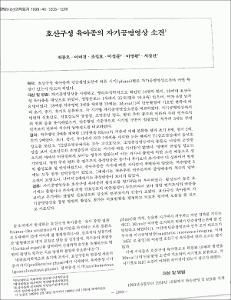호산구성 육아종의 자기공명영상소견
- Keimyung Author(s)
- Lee, Sung Mun
- Department
- Dept. of Radiology (영상의학)
- Journal Title
- 대한방사선의학회지
- Issued Date
- 1999
- Volume
- 40
- Issue
- 6
- Abstract
- Purpose: To describe the MR findings for the three phases of eosinophilic granuloma, as defined by Mirra 'sconventional radiographic criteria. Materials and Methods: Eighteen lesions in 14 patients with proveneosinophilic granuloma were retrospectively analyzed. Among this total, three vertebral lesions were excluded,and the remaining is were classified as early, middle, or late phase on the basis of Mirra's radiographiccriteria. For each phase, we compared MR findings with regard to signal intensity, homogeneity, contrastenhancement, perilesional marrow edema, and soft tissue change. For the three vertebral lesions excluded becausethe application of radiographic criteria was difficult, MR findings for paravertebral soft tissue reaction anddegree of cord compression were compared. Results: Of the fifteen cases classified, eight were early phase, fivewere mid phase, and two were late phase. During each phase, all lesions except one, as seen on T1-weightedimages(T1W1), showed iso-signal intensity. On T2WI, all lesions showed high signal intensity. Contrast studydemonstrated marked contrast enhancement. Thus, no remarkable differences were found in the signal intensitydegree of contrast enhancement of each phase. With regard to heterogeneity, this was demonstrated in most earlyphase lesions, reflecting necrosis and hemorrhage of those lesions. Soft tissue swelling was more severe duringthe early phase than the mid or late phase, but marrow edema was similar in each of the three phase. One of threepatients with vertebra plana showed para-vertebral soft tissue swelling and cord compression, but this was notseen in the two other cases. Conclusion: For evalvating the extent of eosinophilic granuloma and its relationshipwith surrounding structures, MRI was superior to conventional radiography. During the early phase of the disease,lesions showed greater inhomogeneity and more aggressive soft tissue reaction than during the mid and late phase.The use of MRI for the evalvation of eosinophilic granuloma can help decide a therapeutic plan of action andfollow up evaluation.
목적: 호산구성 육아종의 단순촬영소견에 따른 시기(phase)별로 자기공명영상소견에 어떤 특징이 있는지 알고자 하였다.
대상 및 방법: 자기공명영상을 시행하고, 병리조직학적으로 확진된 14명의 환자, 18예의 호산구성 육아종을 대상으로 하였다. 연령분포는 1세에서 35세(평균 10.8세) 였으며, 여자 6명 남자 8명이었다. 18예 중 척추병변 3예를 제외한 15예는, Mirra(l)의 단순촬영에 기초한 분류에 따라 초기, 중기, 후기로 분류하고, 각 시기별 자기공명영상소견을 비교하였다. 자기공명영상에서 병변의 신호강도, 신호강도의 균질성, 조영증강 정도, 병변 주위 골수의 변화와 주위 연부조직의 변화 등을 분석하였으며, 단순촬영 기준만으로 시기별 구분이 힘들었던 척추의 3예는 주변 연부조직 변화와 척수의 압박정도를 비교하였다.
결과: 척추병변 3예를 제외한 15병변을 Mirra의 기준에 의해 분류한 결과 초기 8예, 중기 5예, 후기 2예였다. 초기, 중기, 후기에서 각각 1예씩을 제외한 모든 예에서 T1 강조영상에서 등신호 강도를 보였고, T2강조영상에서는 모두 고신호강도, 조영증강영상에서 중등도 이상의 조영증강을 보여 신호강도와 조영증강의 정도는 시기에 따른 차이점이 없었다. 병변의 균질성 정도는 초기의 예에서 비균질하게 보이는 경우가 많았는데 이는 괴사나 출혈에 의한 소견 때문으로 생각되었다. 병변 주위 변화 중 연부조직 종창반응은 중기나 후기보다 초기에서 더 심하여서 병변의 활성도를 잘 반영하였으나, 골수부종은 시기에 따른 차이점이 뚜렷하지 않았다. 척추병변 3예는 모두 완전 압박골절이 있었고, 1예에서는 척추주위 연부조직의 종창반응과 척수의 압박소견이 보였으나, 나머지 2예에서는 종창반응이 보이지 않았다.
결론: 자기공명영상은 호산구성 육아종의 활성도를 평가하는데 우수하였다. 활성도가 높은 초기에는 출혈이나 괴사에 의한 신호강도의 비균질성이 두드러지며 보다 심한 연부조직의 반응을 보이고 후기에는 균질한 신호강도와 감소된 연부조직의 반응이 보였다. 호산구성 육아종의 자기공명영상을 통한 병변의 활성도 평가는 치료방침을 결정하고 치료후 평가에 도움을 줄 것으로 사료된다.
- Alternative Title
- MR Findings of Eosinophilic Granuloma.
- Keimyung Author(s)(Kor)
- 이성문
- Publisher
- School of Medicine
- Citation
- 최종오 et al. (1999). 호산구성 육아종의 자기공명영상소견. 대한방사선의학회지, 40(6), 1203–1209. doi: 10.3348/jkrs.1999.40.6.1203
- Type
- Article
- ISSN
- 0301-2867
- Appears in Collections:
- 1. School of Medicine (의과대학) > Dept. of Radiology (영상의학)
- 파일 목록
-
-
Download
 oak-bbb-1036.pdf
기타 데이터 / 3.35 MB / Adobe PDF
oak-bbb-1036.pdf
기타 데이터 / 3.35 MB / Adobe PDF
-
Items in Repository are protected by copyright, with all rights reserved, unless otherwise indicated.